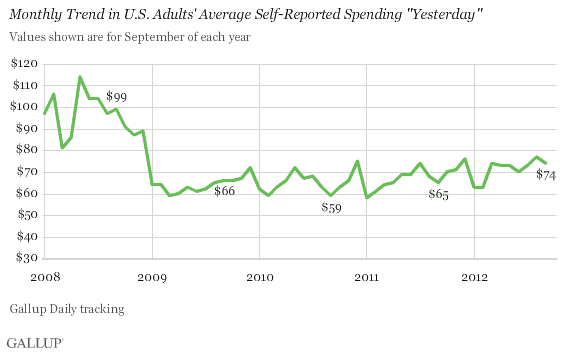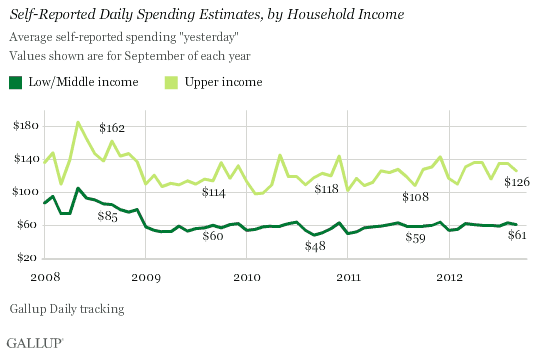WASHINGTON, D.C. -- Americans' self-reported average daily spending fell to $74 in September, after climbing for two months and reaching $77 in August, its highest level in nearly four years. But Americans still spent more this September than they did in any September over the past three years.

The results are based on Gallup Daily tracking from Sept. 1-30. Each night, Gallup asks Americans to report how much they spent the prior day apart from normal household bills or the purchase of a car or home.
Lower- and Higher-Income Consumers Pull Back on Spending
Lower- and middle-income consumers, as well as those with upper incomes, spent less on average in September than in August. But upper-income spending in September was still higher than in the same month in 2009, 2010, and 2011. Lower-income Americans' average daily spending of $61 in September is on par with what it was in September of last year and 2009, but is higher than in September 2010.
Both groups' spending remains far lower compared with September 2008.

Bottom Line
After rising to an almost four-year high in August, Americans' spending slid back slightly in September. This may be partly tied to diminishing back-to-school spending. In 2010 and 2011, Americans' spending also declined from August to September. However, there are likely other issues influencing consumers' mood. The uncertainty of the election outcome, fear of the possible "fiscal cliff" fallout, and signs of a slowing global economy may all be affecting Americans' spending habits.
Additionally, spending declined in September even as Americans' confidence in the economy increased -- mainly due to Democrats' improved economic outlook, revealing that these politically influenced attitudes are not translating into economically optimistic behavior.
Gallup.com reports results from these indexes in daily, weekly, and monthly averages and in Gallup.com stories. Complete trend data are always available to view and export in the following charts:
Daily: Employment, Economic Confidence, Job Creation, Consumer Spending
Weekly: Employment, Economic Confidence, Job Creation, Consumer Spending
Read more about Gallup's economic measures.
View our economic release schedule.
Survey Methods
Results are based on telephone interviews conducted as part of Gallup Daily tracking Sept. 1-30, 2012, with a random sample of 14,390 adults, aged 18 and older, living in all 50 U.S. states and the District of Columbia.
For results based on the total sample of national adults, one can say with 95% confidence that the maximum margin of sampling error is ±1 percentage point.
The estimates for average daily spending have a margin of sampling error of ±$4.
Interviews are conducted with respondents on landline telephones and cellular phones, with interviews conducted in Spanish for respondents who are primarily Spanish-speaking. Each sample includes a minimum quota of 400 cell phone respondents and 600 landline respondents per 1,000 national adults, with additional minimum quotas among landline respondents by region. Landline telephone numbers are chosen at random among listed telephone numbers. Cell phone numbers are selected using random-digit-dial methods. Landline respondents are chosen at random within each household on the basis of which member had the most recent birthday.
Samples are weighted by gender, age, race, Hispanic ethnicity, education, region, adults in the household, and phone status (cell phone only/landline only/both, cell phone mostly, and having an unlisted landline number). Demographic weighting targets are based on the March 2011 Current Population Survey figures for the aged 18 and older non-institutionalized population living in U.S. telephone households. All reported margins of sampling error include the computed design effects for weighting and sample design.
In addition to sampling error, question wording and practical difficulties in conducting surveys can introduce error or bias into the findings of public opinion polls.
For more details on Gallup's polling methodology, visit www.gallup.com.
